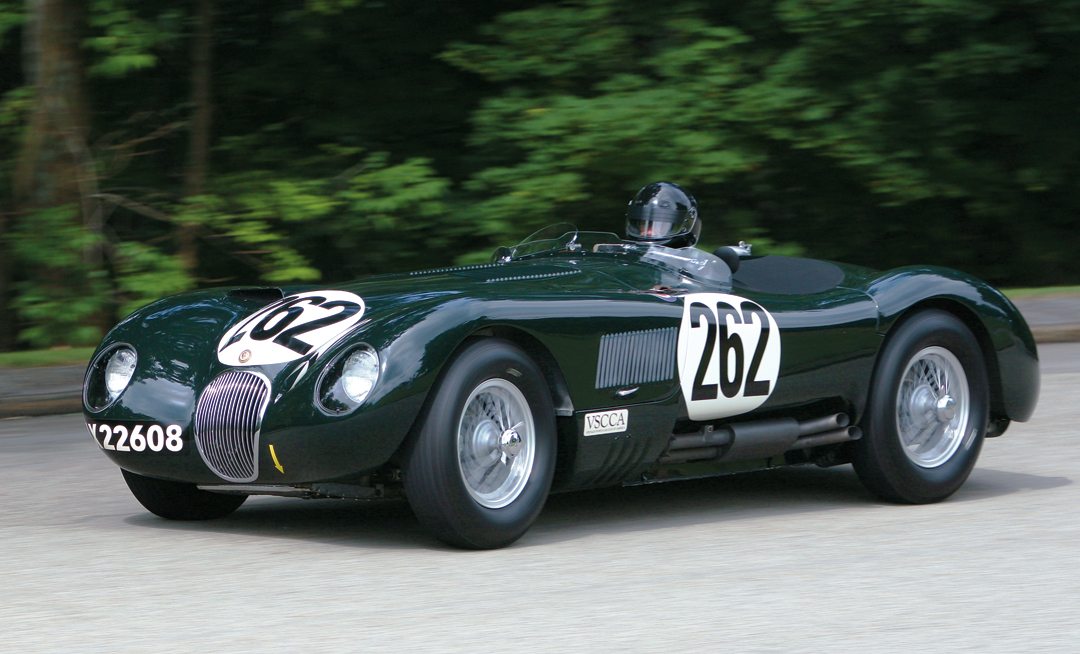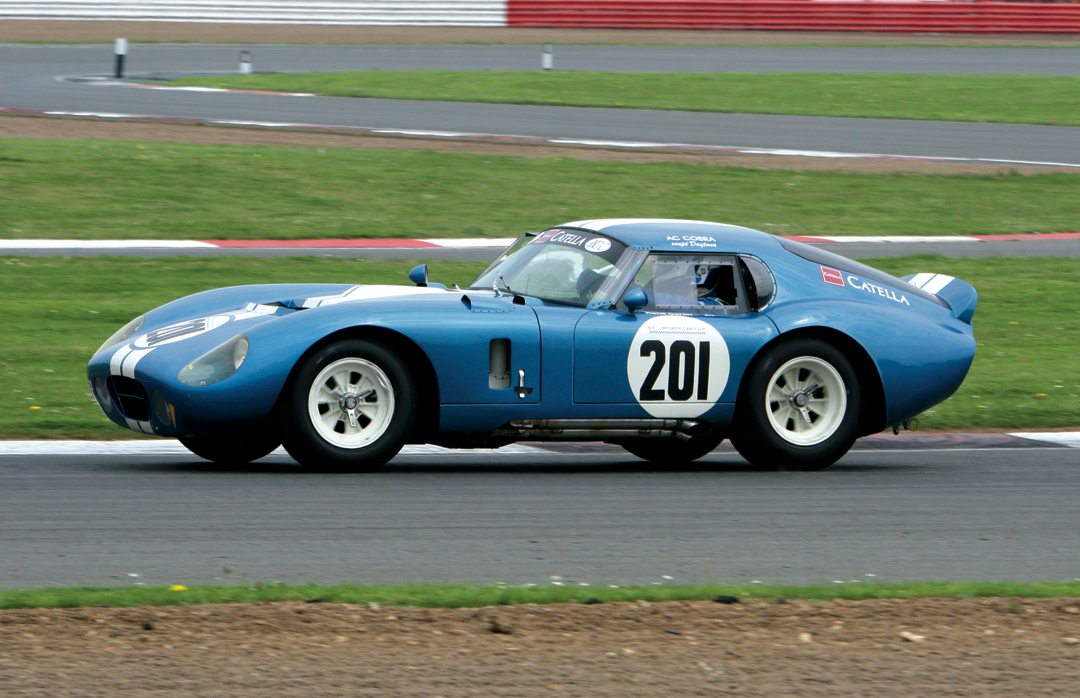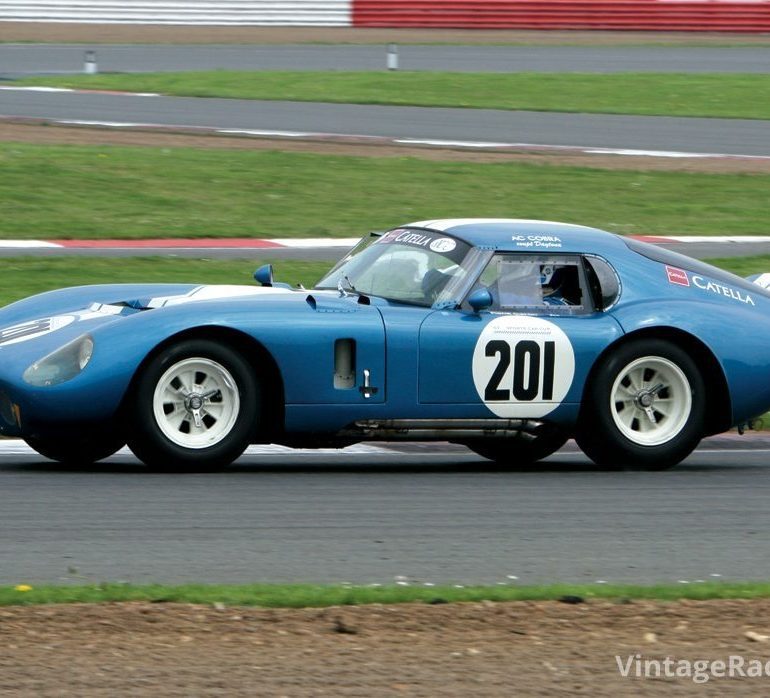Over two-liter Grand Touring cars have always had a place to compete within the ever-changing regulations of international motorsports; the World Sports Car Championship from 1953-1961, the Speedworld Challenge from 1962-1963, and the International Championship of Makes from 1972-1981. This included racing in the great endurance races such as the 24 Hours of Le Mans, the 1000 Kilometers of Nürburgring, Spa and Monza, and the Targa Florio. Aston Martin, Ferrari, Jaguar, Porsche and Ford (by backing Carroll Shelby with the Cobra), all designed very lightweight, successful competition cars to compete in the GT category. In the USA these cars raced in the SCCA and the USRRC.
Today, GT cars qualify to race in many great historic events such as the Tour (de France) Auto, Tour of Spain and Targa Florio because they are dual-purpose race and street cars. They also qualify for the Le Mans 24 Hour Classic and, in the USA, the Monterey Historics and all other race events and tours. Due to their technology, great designs, event eligibility and low production numbers, GT cars have steadily been increasing in value.
Additionally, there was also the popular American series for racing “Sedans,” the Trans-Am Championship, which started in 1966 and, for the purposes of this guide, goes through 1972. This was exciting racing with all of the big American manufacturers involved.
Today, there is a historic Trans-Am group that is always a crowd pleaser. These cars have also proven their worth and have been increasing in value, with buyers paying a premium for team cars with history.
| Make | Model | Level III | Level II | Level I |
| AMC Javelin |
‘68-’72 Trans Am Team |
$700,000 | $800,000 | $900,000 |
|
‘69-’71 Trans Am Independent |
$150,000 | $175,000 | $250,000 | |
| Aston Martin | DB2 | $225,000 | $325,000 | $475,000 |
| DB4 GT | $2,000,000 | $2,500,000 | $3,000,000 | |
| DB4 GT Zagato | $8,000,000 | $9,000,000 | $10,000,000 | |
| Austin-Healey | 100 M | $100,000 | $150,000 | $175,000 |
| 100 S | $700,000 | $850,000 | $1,000,000 | |
| 100-6 MM | $65,000 | $85,000 | $110,000 | |
| 3000 | $60,000 | $80,000 | $110,000 | |
| Bizzarrini | 5300 Strada | $700,000 | $800,000 | $900,000 |
| BMW | 3.0CSL Group 2 | $600,000 | $800,000 | $1,000,000 |
| 3.5CSL M49 | $1,500,000 | $1,800,000 | $2,000,000 | |
| Chevrolet Camaro |
‘67-’71 Trans Am Team Penske |
$800,000 | $875,000 | $950,000 |
|
‘66-’70 Trans Am Independent |
$175,000 | $175,000 | $250,000 | |
| Chevrolet Corvette | Greenwood 1974-1977 | $300,000 | $400,000 | $600,000 |
| BFG 1968-1969 | $750,000 | $825,000 | $900,000 | |
| J.G. 1968-1969 | $700,000 | $750,000 | $850,000 | |
| Chevrolet | ‘56-’62 Corvette | $50,000 | $75,000 | $125,000 |
| ‘63-’67 Corvette | $50,000 | $100,000 | $150,000 | |
| ‘68-’72 Corvette | $50,000 | $100,000 | $150,000 | |
| Cobra | 289 Team Comp | $2,000,000 | $2,200,000 | $2,500,000 |
| 289 Ind. Comp | $800,000 | $1,000,000 | $1,300.000 | |
| 289 USRRC | $2,500,000 | $2,700,000 | $3,000,000 | |
| 289 FIA | $3,500,000 | $4,000,000 | $4,500,000 | |
| 289 Daytona Coupe | $8,000,000 | $9,000,000 | $10,000,000 | |
| 427 S/C | $2,000,000 | $2,200,000 | $2,500,000 | |
| Dodge Challenger |
‘70-’71 Trans Am Team |
$600,000 | $650,000 | $750,000 |
|
‘70-’71 Trans Am Independent |
$150,000 | $175,000 | $250,000 | |
| Ferrari | 250 GT TDF | $8,000,000 | $10,000,000 | $12,000,000 |
| 250 GT LWB Alloy CA Spyder | $12,000,000 | $14,000,000 | $16,000,000 | |
| 250 GT SWB Alloy CA Spyder | $16,000,000 | $18,000,000 | $20,000,000 | |
| 250 GT SWB Alloy Comp | $10,000,000 | $12,000,000 | $14,000,000 | |
| 250 GTO Series I II | $40,000,000 | $45,000,000 | $50,000,000 | |
| 330 LMB | $30,000,000 | $35,000,000 | $40,000,000 | |
| 250/275 LM | $12,000,000 | $15,000,000 | $17,000,000 | |
| 275 GTB Comp | $3,000,000 | $3,500,000 | $4,000,000 | |
| 275 GTB-C Comp | $6,000,000 | $7,000,000 | $9,000,000 | |
| 365 GTB4 Comp | $3,000,000 | $4,000,000 | $4,500,000 | |
|
Ford Shelby Mustang Notch Back |
Trans-Am ‘66-’68 Team | $200,000 | $300,000 | $350,000 |
| Trans-Am ‘66-’68 Independent | $125,000 | $150,000 | $200,000 | |
| Ford Mustang Boss 302 |
Trans-Am ’69-‘72 Team |
$700,000 | $800,000 | $900,000 |
|
Trans-Am ’69-‘72 Independent |
$150,000 | $175,000 | $250,000 | |
| Ford | Capri Group 2 | $300,000 | $350,000 | $400,000 |
| Griffith | 200/400 Series | $50,000 | $75,000 | $100,000 |
| Iso Grifo | A3C Corsa | $1,500,000 | $2,000,000 | $2,500,000 |
| C-Type | $4,000,000 | $5,000,000 | $6,000,000 | |
| D-Type | $6,000,000 | $10,000,000 | $20,000,000 | |
| Jaguar | XKSS | $8,000,000 | $10,000,000 | $12,000,000 |
| XK120 | $100,000 | $125,000 | $175,000 | |
| XK120 Alloy | $350,000 | $425,000 | $500,000 | |
| XKE Lightweight | $6,000,000 | $7,000,000 | $8,000,000 | |
| Ligier | JS1 | $125,000 | $150,000 | $175,000 |
| Ligier | JS2 | $400,000 | $450,000 | $500,000 |
| Plymouth Barracuda | ‘70-’71 Trans Am Team | $500,000 | $600,000 | $700,000 |
| ‘70-’71 Trans Am Independent | $125,000 | $175,000 | $250,000 | |
| Pontiac Firebird | ‘70-’71 Trans Am Team | $500,000 | $600,000 | $700,000 |
| ‘70-’71 Trans Am Independent | $125,000 | $175,000 | $250,000 | |
| Porsche | 911 ST | $1,200,000 | $1,600,000 | $2,000,000 |
| 911 RS 2.7 Lightweight | $700,000 | $900,000 | $1,200,000 | |
| 911 RSR 2.8/3.0 | $1,200,000 | $1,600,000 | $2,000,000 | |
| Shelby | GT350 ’65 | $225,000 | $275,000 | $325,000 |
| GT350 R ’65 | $700,000 | $800,000 | $900,000 | |
| Sunbeam | Tiger 260/289 | $90,000 | $110,000 | $135,000 |
1953 Jaguar C-Type

Jaguar Cars in Coventry had come out of WWII intact and begun producing its XK 120 models. The XK120 had its own racing success, as well as setting some speed records. Jaguar had a serious interest in international racing, in particular the famed 24 Hours of Le Mans endurance race, each June, at the eight-mile Circuit de la Sarthe. To achieve success, Jaguar built the C-Type with a lightweight, multi-tubular frame designed by William Haynes, and an aerodynamic, all-aluminum body designed by Malcolm Sayer. The 3.4-liter, inline six-cylinder engine from the XK production car was modified with triple carburetors and high-lift camshafts to produce 220 bhp. The Moss 4-speed gearbox was used. Disc brakes were added for superior stopping power. A lightweight, nimble, good handling racecar was created, with 53 cars built from May 1952 until August 1953. Of those, 43 were sold into private hands, with many going to the USA. The C-Type won the 24 Hours of Le Mans outright twice, in 1951 and 1953. This against the might of Ferrari with its 12-cylinder cars and Mercedes-Benz with its new 300SL.
The C-Type set many new standards, including the use of 4-wheel disc brakes long before Ferrari, Mercedes or Maserati. This was a time in motor racing when a manufacturer saw the value of engineering a car for racing in international competition. Today the C-Type is highly sought after among collectors, and a joy to see at concours or historic races.
1965 Cobra Daytona Coupe

There was a time, in automotive history, when one man with passion, entrepreneurship and a vision could make a difference in the racing world. It all started from humble beginnings in a shop in Venice, California. Carroll Shelby and his connection to Ford in the 1960s was an example of that time and its resulting success. Shelby and his talented band of hot rodders, fabricators and racers had created the 289 Ford V8-powered Cobra roadster and started racing it. In search of a more aerodynamic shape and faster car, the beautiful Cobra Daytona Coupe was designed around a wrecked roadster. This rebody of an existing model was allowed by the FIA homologation rules. The Daytona was specifically designed for the high-speed European race circuits with the goal of winning the FIA GT World Sports Car Championship. The aerodynamic body was designed by Pete Brock, and the suspension by Bob Negstad. The first car was built in Venice and tested at Riverside. The remaining bodies were built by Carrozzeria Gran Sport in Italy. Only six cars were built. Success came with class wins at Sebring, Le Mans, Daytona, Monza, Nürburgring, Reims and other circuits, and resulted in a Manufacturers World GT Championship against the might of Ferrari, Porsche Aston Martin, Jaguar and others that was the first for an American car constructor. Today, these cars are in the hands of some great collections and a joy to see when brought out to the races. An appreciating asset and part of racing history.
Criteria Used For Assessing Valuations for this Guide:
- Degree of Originality
- Overall Condition, Restoration
- Technology, Design, Coachbuilder
- Production Numbers/Rarity
- Competition History
- Ownership History, Documentation
- Modern Event Eligibility
Regional Variances
The prices stated in this guide are based on U.S. values. The values of historic racing cars can vary as much as 25%-35% in other countries, depending on local market appeal, currency rates, import duties, and VAT. Most of the time, we are able to document known sales or closed escrows, as they say in real estate. When this is not possible, a logical estimate of the car’s value is given, based on its sales history and relationship to cars of its type.
The prices stated in this guide are based on U.S. values. The values of historic racing cars can vary as much as 25%-35% in other countries, depending on local market appeal, currency rates, import duties, and VAT.
LEVEL |
VALUATION CATEGORIES |
|---|---|
I |
The best combination of all criteria. |
II |
Satisfies mid-range of criteria. |
III |
In need of restoration. Meets only a few points of criteria |




